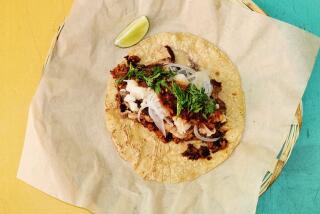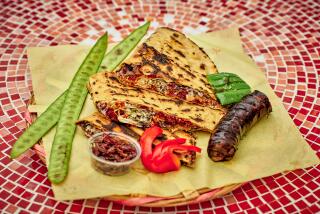Savoring Authentic Mexican Food
- Share via
ACAPULCO, Mexico — After a busy day in the heat and bustle of downtown Acapulco, the drive into the hills at sunset was a welcome respite.
At a small restaurant called Tlaquepaque we entered a cool patio hung with lush plants and draped by flowering vines. As we sat down a small, quiet-spoken man with gentle eyes and a face creased by many smiles came to our table and offered us a platter of orange slices, spears of sweet pineapple and pieces of jicama.
“When people come up here, they may have a bitter taste in their mouth,” said Jose Santiago Arreola, the restaurant’s owner. “So they take a bite of this as soon as they get here, and they feel better.”
We squeezed a little lime over the jicama, dipped some slices into the small mound of chili powder on the table and bit into the crunchy, slightly tart slices. Senor Arreola was right. We relaxed, and the cares of the day seemed to evaporate into the warm air.
Arreola worked for 15 years as executive chef at the Pierre Marques hotel south of the city before starting Tlaquepaque 18 years ago. Acapulco has good restaurants that offer the area’s specialties--fresh seafood, cabrito or baby goat, and beef--but Arreola serves some of the best and most authentic Mexican food in the region.
From time to time he’ll offer such local delicacies as iguana and armadillo, and on Thursdays, Acapulco residents line up for his pozole , the hearty corn stew that is a weekly tradition here.
This night he was serving more conventional Mexican dishes from an open kitchen at one end of the patio, where Malena Hernandez, who has worked here for 14 years, was cooking handmade tortillas on a griddle.
After the welcoming fruit platter came small tostadas topped with quail livers that had been sauteed with onions and chili. The toasted tortillas were delicate, crisp and not greasy. A small dish of hard-cooked quail eggs were accompanied by a sauce that reminded us of slightly spicy Russian dressing.
A thick, aromatic garlic soup came with an egg whipped into it and slices of chicken added, and the chili rellenos we ordered were exquisite. Two tender yet still crunchy chiles arrived steaming from the stove. One was filled with mild cheese and slices of chicken, and the other with a stuffing of ground meat and spices. A light covering of cream was a perfect addition.
The main courses were a mesquite-grilled quail that had been grown on Arreola’s farm. It was full of flavor and smoky richness. The other was grilled pork in a slightly piquant chile verde. Main dishes were accompanied by spinach, white rice, fried bananas and nopales , pieces of prickly pear cactus. For dessert there was an assortment of Mexican candies including leche quemada , something like a praline.
Tlaquepaque is in a residential neighborhood, about a $5 taxi ride from the center of town. Figure on about $20 per person for dinner.
We have found that dining well on authentic Mexican food in Acapulco is not easy. True, there are the excellent restaurants at Las Brisas and some of the other hotels, and we have had some enjoyable evenings over a steak at Cocula or fish at Pipo’s, or even baby goat at Cabrito, but finding the complex cuisine that makes dining in Mexico such an adventure is not easy.
Acapulco’s other great Mexican restaurant is La Hacienda, on the grounds of the Acapulco Princess a few miles south of town. As formal as Tlaquepaque is casual, La Hacienda captures a feeling of romance. Just steps from the Pacific Ocean, it is softly lit by candles, and a string band plays Mexican tunes in a softer style than mariachi music.
We began with chile rellenos without coating, stuffed with cheese and served in nogada --a cream sauce sprinkled with pine nuts that was so good we scooped it onto bread to get every last bit. Another first course was a crepe stuffed with huitlacoche .
Perhaps the most Mexican of dishes, huitlacoche is a black fungus that appears on fresh corn. The flavor is something between sweet corn and mushrooms, not only memorable but delicious.
For a main course we both tried lamb baked in mixiote . The membrane of an agave leaf is cleaned and wrapped around chunks of lamb flavored with tomatoes and chiles and then baked in a hot oven. It looks like parchment paper when it emerges from the oven, but the mixiote flavors the lamb in the slow cooking. It’s an unforgettable flavor.
For dessert there was a selection of cakes and pastries, but we tried the flan, a caramel custard. It was light, smooth and not too sweet. The cafe de olla there is excellent--a blend of cinnamon, orange peel and coffee, simmered in a clay pot. Dinner at La Hacienda should cost you about $35 per person.
All along Acapulco’s main waterfront street, Costera Miguel Aleman, are restaurants and hotels offering a bewildering variety of food, from American fast food to Chinese and Japanese foods.
Following the advice of a friend who lives in Acapulco we tried Pipo for the seafood. Festooned with nets and nautical gear, the open-air restaurant offers fresh fish and shellfish, practically off the boat, in a casual setting. This is a good place to try ceviche, a local specialty of raw fish, usually sea bass or red snapper, that has been marinated for 24 hours in lime juice and is served with chiles, chopped green onions, cilantro, tomatoes and garlic.
Shrimp, octopus and abalone are also popular there, and the paella , a Spanish dish of rice and a variety of fresh seafood, is a standout. Dinner here will cost about $15 per person.
Barbecued baby goat is another favorite in Mexico, and several are usually spread before the open fire behind a picture window at El Cabrito. Brightly colored cloths cover the tables in this open-air, casual restaurant, and the moist and tender cabrito costs about $12.
Beef is the specialty at Cocula, a pleasant restaurant with an open-air patio in front and a cozy bar with leather chairs inside. You can sit outside beneath palm trees ringed with tiny white Tivoli lights and try the carne asada (charbroiled meat), sirloin steaks, filets and ribs.
You’ll discover that Mexican beef is leaner and chewier than U.S. beef but still is quite flavorful. Chicken, quail and fish also are offered, and the pozole , served there on Thursdays, is said to be second only to Tlaquepaque’s. Dinner will cost between $15 and $20 per person.
For dinner with a spectacular view, one of the best places is Los Rancheros on the main highway leading south from the city. It’s popular with tourists, but the vista of Santa Lucia Bay, a crescent of blue with Acapulco’s high-rises in the background, makes it worth the trip. The terrace has red-tiled floors and a railing of rough-hewn logs.
We sat there with friends and shared plates of tamales, tacos, enchiladas with chicken and chiles relleno . This restaurant is large and friendly, with lots of excitement, especially at night during the season. Dinners cost $15 to $18 per person.
Everyone asks the same question about dining in Mexico, and in answer, we give this advice: The major hotels have purified water and wash their vegetables well. When in doubt, avoid uncooked vegetables and fresh fruits that you don’t peel yourself. Drink bottled water and order your drinks without ice. More than anything, eat and drink in moderation for the first couple of days.
Recommended: Restaurant Tlaquepaque, Calle No. 1, Lote 7. La Hacienda, Acapulco Princess, midway between the airport and downtown. Mariscos Pipo, Avenue Costera Miguel Aleman at Nao Victoria. Cocula Steak House, Costera Miguel Aleman. El Cabrito, Costera Miguel Aleman No. 1480. Los Rancheros, Carretera Escenica 350.
More to Read
Eat your way across L.A.
Get our weekly Tasting Notes newsletter for reviews, news and more.
You may occasionally receive promotional content from the Los Angeles Times.










